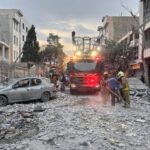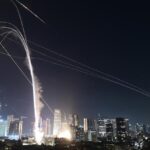Army vehicle and aircrews were hard at work this week preparing for a massive military parade Saturday to honor the 250th anniversary of the service’s founding, a celebration that coincides with President Donald Trump’s 79th birthday.
Thousands of soldiers have descended upon Washington, D.C., from more than a dozen Army divisions across the force, and many of them have meticulously prepared their machines to roll down Constitution Avenue. They have also planned for contingencies in the event of a breakdown, inclement weather or disruptors.
The festivities are estimated to cost as much as $45 million, which Trump said was “peanuts compared to the value of doing it” in an interview last month. The Army has pitched the parade as an opportunity to better connect with the American public, recruit potential soldiers and share its service heritage.
Read Next: One Soldier Dead, Another Injured in Fort Campbell Helicopter Training Crash
But national events this week have overshadowed the parade, with Trump deploying 4,000 National Guard troops and 700 active-duty Marines to Los Angeles in the face of protests about his administration’s increasingly aggressive immigration raids and over the objections of the California governor and LA mayor. Trump’s invective-laced political speech to Army soldiers at Fort Bragg this week also sparked widespread concerns over a splintering of the military’s apolitical nature.
And the parade itself risks other potential pitfalls, with limited strategic benefits, experts said. The optics of a broken-down tank or other disruption of the procession in the nation’s capital could cause an international spectacle.
“I don’t see a lot of strategic upside to this,” said Yvonne Chiu, a fellow at the American Enterprise Institute who focuses on defense and authoritarianism. “From the outside, it’s a chance to show off the Army, show off its capability, [but] it’s unclear to me that the United States really needs to do that.”
Alex Plitsas, a fellow with the Atlantic Council, said he didn’t “see any value in terms of projection of power or anything else,” and both agreed that adversaries and partners are already well aware of the U.S. military’s power and capabilities expected to be shown during the parade.
About 150 tanks, Bradley Fighting Vehicles, Strykers, Paladins and other vehicles will pass in front of the White House, where Trump will receive an American flag from the Army’s Golden Knights parachute team after they descend on to the Ellipse. Dozens of aircraft of many stripes, from the UH-60 Black Hawk to the P-51 Mustang will buzz across the sky — in some cases, a few hundred feet off the ground — and soldiers in period uniforms will march alongside military working animals.
The festivities have grown in size and scope in the last few months. There are an untold number of factors that top brass to junior troops have had to quickly wrangle, and subsequently an equal number of things that could go awry, small or big.
In parades held by other countries, those usually led by authoritarian regimes, breakdowns along a parade route become instant fodder for international ridicule. During a rehearsal for a 2015 Victory Day parade in Moscow, Russia’s then-new T-14 Armata battle tank temporarily stopped on Red Square as others rolled on, requiring a tow to be called out before it eventually continued under its own power, for example.
If something similar happens Saturday, adversaries such as Russia, North Korea, China or Iran could use it as “propaganda to denigrate the military,” Plitsas said, adding that it would present an opportunity for those countries to claim the U.S. military is not as strong as it says it is and “it’s all sort of a facade.”

All of the crews Military.com spoke to this week were confident in their equipment’s ability to perform during the parade. Many of those vehicles have a reputation as temperamental fuel hogs, but given the global intrigue, the most reliable vehicles were likely selected.
A former armor officer told Military.com that, if it were them participating in the parade, breaking down would constitute a “worst fear” type scenario. A collision would also be bad, they said, but the vehicles are expected to drive slowly.
“That’s probably why you don’t see these very often, because it’s so visible,” they said. “If something goes wrong, it looks really ugly for the Army and it undercuts your legitimacy.”
“I think that it ends up being kind of high-risk,” they added, noting they would be conscious of the optics. “I’m sure that their leadership has impressed that upon them that the [preventative maintenance checks and services] that [they’re] doing from three months out until every day until the event is because this is a global event and has attention.”
Crews on the M1A2 Abrams, Bradleys, Strykers and Paladins have been conducting preventative maintenance checks and services every day since they arrived, instead of the traditional “motorpool Monday” once a week, Col. Kamil Sztalkoper, a spokesperson for III Armored Corps out of Fort Cavazos, Texas, told Military.com on Wednesday.
“We have taken a lot of steps to make sure nothing breaks down,” he said when asked about the strategic risk of a breakdown. “We are feeling extremely confident. It starts, it’s rolling, it’s not going to stop.”
Sgt. Jesse Sattler, a tank gunner who will be participating in the parade Saturday, said that his crew’s tank recently came out of full services — an in-depth check by a mechanic team — and that they replaced the track pads to help mitigate damage to the road and some road wheels, and applied a fresh coat of green paint (no nicknames on the gun tubes), among other tasks. The Army Corps of Engineers installed metal plates at pivot points along the route to help prevent damage to the roads.
“We’re not too concerned about any of our tanks breaking down since they just came out of services and they’re really well maintained tanks,” said 1st Lt. Kaessey Thompson, a platoon leader and tank commander.
But like any mission, the service has planned for maintenance troubles should they occur: Multiple M88 Hercules and other recovery vehicles will be on standby; roughly a dozen civilian experts were dispatched to the nation’s capital to offer their services; contact trucks with parts and fluids are at the ready; recovery plans are established with several crews saying that they have rehearsed those plans; and no one is expecting to “throw track.”

Still, “that is definitely a concern if that were to happen,” Plitsas said, referring generally to a breakdown. “It’s the equipment version of the guy on parade detail who locks out his knees and ends up passing out in formation, which always ends up on the internet making viral rounds. This time, it’s tech.”
Chiu said adversarial countries would likely use it as an opportunity to denigrate the U.S. military. But she said she wasn’t “too concerned about that sticking as a criticism” and expected that “the American public is going to be pretty forgiving about that” if it were to happen.
“There’s plenty of criticism being lobbed at the United States already in the global arena that this one thing in and of itself is not going to make or break the U.S. reputation,” she added.
Meanwhile, protests are expected to kick off in hundreds of cities across the country on Saturday, including Washington, D.C. Combined with the Army expecting hundreds of thousands of parade attendees, roads will be crowded.
Vehicle crews will have their heads out of their hatches during the parade, and vehicles will vary incrementally by type along the parade route. Sattler told Military.com that if a protester attempted to block their path, there’s a plan for that too.
“Safety is a big priority out there. We don’t need any incidents, so at all costs, if anything happens where a person may come into the parade field, it’s [an] immediate stop the vehicle and allow the civilian authorities to take care of the matter,” he said.
Even weather could be a factor. Forecasts for Saturday showed potential thunderstorms, rain and lightning, but it was unclear whether those conditions would be isolated.
Inclement weather isn’t expected to cancel the presentation of the ground vehicles, but aircrews said they’re monitoring the weather closely as they conduct their own helicopter maintenance.
“We’re going to make sure that we stay safe and stay clear of the other aircraft so that all of us can go home to our families,” said Capt. Colton Curry, an AH-64 Apache pilot. Of the weather, he added, “there’s some hard and fast rules that go into it; ultimately, it comes down to the safety of the aircrew, so we’re not going to do anything that is going to jeopardize the safety of the flight.”
Related: Army Birthday Celebration Falls in Shadow of LA Military Deployment, Immigration Policy Protests




